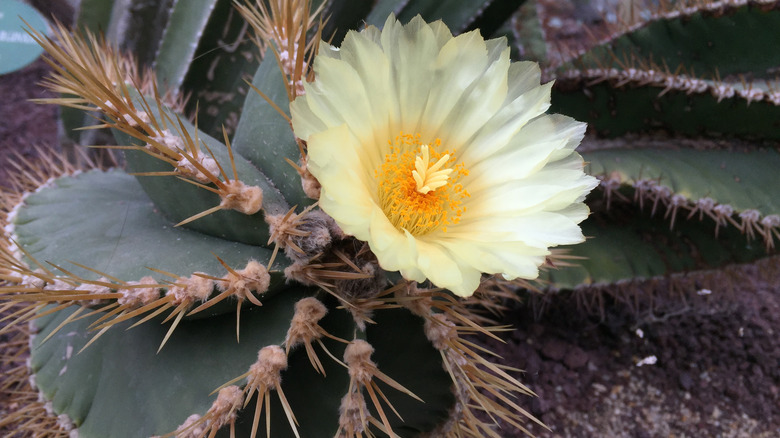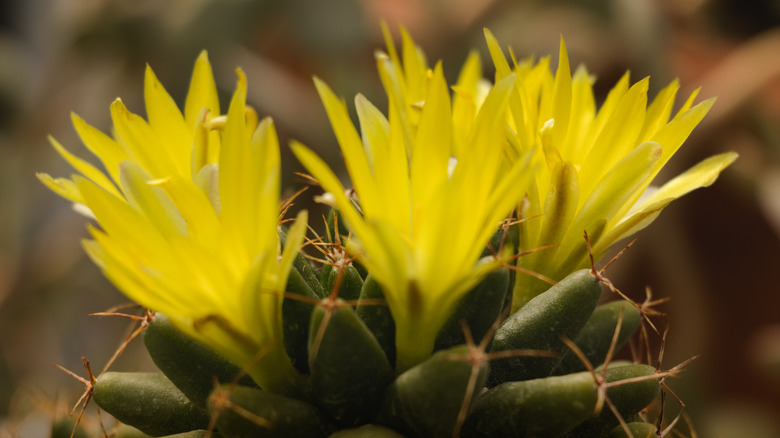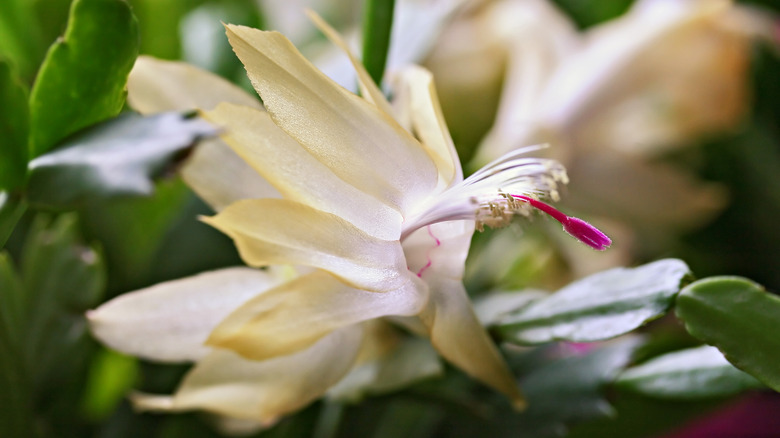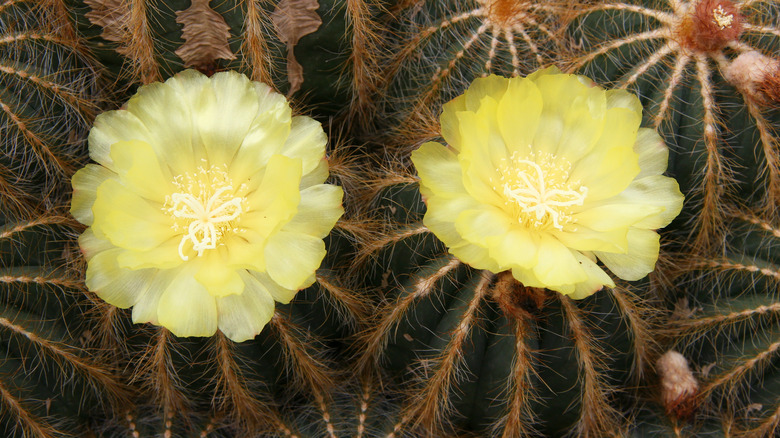15 Succulents That Bloom With Bright Yellow Flowers
Who doesn't love the sight of cheery yellow blossoms all year long? Bright tulips and daffodils rule spring, golden black-eyed Susans are often used in the summer, fall brings yellow marigolds and sunflowers, and winter finishes it all off with some blooming wintersweet and witch hazel. However, what each of these flowering plants has in common is that they all require different levels of attentive care. Not to mention, many are treated as annuals in certain climates, or they simply don't live very long. So if you are looking for yellow-blooming plants that you won't have to maintain year after year, flowering succulents and cacti could be right up your alley.
Warm-weather and low-maintenance plants, such as aloe vera, Christmas cacti, and eastern prickly pear cacti, can all be easily grown indoors or outdoors, and they consistently bloom as long as the temperatures are high enough. Longfield Gardens suggests using yellow blooming plants in your home garden to bring forth good cheer and a sunny glow. Many succulent and cacti species produce flowers of this color; you just have to know what you're looking for. For your pleasure, we've compiled a list of 15 different plants with fleshy leaves and sharp spines that flower with bright yellow blossoms in all four seasons.
1. Basketball plant
The basketball plant (Euphorbia obesa) is known for its round shape that makes it look like a green, leathery ball. Sometimes, older basketball plants become taller and more cylindrical as they age, which makes them harder to identify. One way you can recognize the succulent is by looking at its yellow flowers that bloom in the summer, as per Planet Desert.
Bloom Season: Summer
USDA Growing Zone: 10 to 11
Growing Conditions: Full sun to partial shade
Soil Type: Coarse and well-draining
Size: 6 to 12 inches tall
2. Pulido's echeveria
Pulido's echeveria (Echeveria pulidonis) is a member of the stonecrops family. Because of this, it is commonly mistaken for its cousins, such as lipstick echeveria, Mexican gems, and the painted lady. However, this plant has similar growing conditions to other echeveria species like these. It needs some direct sunlight each day, well-draining soil, and very little water, notes San Marcos Growers.
Bloom Season: Winter and spring
USDA Growing Zone: 9 to 12
Growing Conditions: Full sun to partial shade
Soil Type: Well-draining
Size: Less than 1 foot tall
3. Bishop's hat cactus
The bishop's hat cactus (Astrophytum myriostigma) can be identified by its unique star shape that is created by the succulent's four or five ribs. It's on these ribs that the yellow flowers appear in the summer. Typically, the blooms are somewhat large compared to the rest of the plant, and they are funnel-shaped. The University of Arizona states that they are also fragrant, which helps attract pollinators.
Bloom Season: Summer
USDA Growing Zone: 7 to 11
Growing Conditions: Full sun to light shade
Soil Type: Well-draining sand and chalk
Size: Up to 5 feet tall
4. Monk's hood cactus
The monk's hood cactus (Astrophytum ornatum), also called the star cactus, is a unique succulent plant that grows into a twisted, columnar shape, as described by Mountain Crest Gardens. The stem shows off several ribs, which are lined with yellow spines. When planted in direct sunlight and well-draining soil, these cacti produce yellow flowers in the summer.
Bloom Season: Summer
USDA Growing Zone: 10 to 11
Growing Conditions: Full sun
Soil Type: Well-draining
Size: Up to 6 feet tall
5. Golden barrel cactus
The golden barrel cactus (Echinocactus grusonii) is known to be one of the most popular and well-known cacti overall, per the University of Vermont. It is easily recognized by its spherical body lined with many ribs that are covered in yellowish spines. Like other blooming cacti, the golden barrel cactus gives life to yellow flowers in the summer, which are described as bell-shaped.
Bloom Season: Summer
USDA Growing Zone: 9 to 12
Growing Conditions: Full sun
Soil Type: Coarse and well-draining
Size: 2 to 3 feet tall
6. Sand dollar cactus
Sand dollar cacti (Astrophytum asterias), which can look quite similar to the basketball cactus, is a round succulent that also produces yellow flowers in the summer, as told by Planet Desert. The sand dollar cactus is a very low-maintenance plant; however, it grows quite slowly. With some light shade and well-draining soil, it should thrive indoors or outdoors as long as it doesn't experience temperatures below 20 degrees Fahrenheit.
Bloom Season: Summer
USDA Growing Zone: 9 to 11
Growing Conditions: Partial shade
Soil Type: Well-draining
Size: 6 to 12 inches tall
7. Pincushion cactus
Pincushion cacti (Mammillaria spp.) are among the most popular succulents people keep. They are easy to grow, long-lasting, and bloom with flowers that may be yellow, green, pink, red, or white, as noted by North Carolina State Extension. Additionally, they produce pups that can be propagated to grow more cacti that can be given as gifts or added to your houseplant collection.
Bloom Season: Summer and fall
USDA Growing Zone: 10 to 11
Growing Conditions: Full sun or partial shade
Soil Type: Well-draining
Size: 1 inch tall to 1 foot tall
8. Echeveria 'Dondo'
Echeveria 'Dondo' (Echeveria derenbergii x E. runyonii or Echeveria derenbergii x E. setosa) is a beautiful and uniform succulent plant that features blue-green leaves and flower stalks that show off yellow or orange blooms above the fleshy foliage, as per San Marcos Growers. Little is known about the parentage of Echeveria 'Dondo,' which makes its origin unclear. Still, it has similar care needs to other Echeveria species.
Bloom Season: Spring to winter
USDA Growing Zone: 9 to 11
Growing Conditions: Partial shade
Soil Type: Well-draining
Size: Less than 1 foot tall
9. Christmas cactus
Christmas cacti (Schlumbergera russelliana) are common indoor plants that are grown for their flowers that appear during the holiday season, hence their name. North Carolina State Extension mentions that this cactus most often shows off pink or red blooms, but some varieties can have yellow, purple, or white blossoms instead.
Bloom Season: Fall and winter
USDA Growing Zone: 9 to 11
Growing Conditions: Full sun
Soil Type: Moist and well-draining
Size: 6 inches to 1 foot tall
10. Balloon cactus
The balloon cactus (Parodia magnifica) gets its name from its balloon-like shape. This species of cacti are native to Southern Brazil, and it is extremely easy to care for. Still, Planet Desert warns that you should never overwater the balloon cactus, or else you risk root rot or rot from the inside, which can cause irreversible damage.
Bloom Season: Summer to fall
USDA Growing Zone: 9 to 11
Growing Conditions: Full sun
Soil Type: Well-draining chalk, sand, or loam
Size: 10 inches to 1 foot tall
11. Aloe vera
Aloe (Aloe barbadensis) is a well-known succulent that is grown indoors and outdoors worldwide. However, few people realize that when you provide the plant with exactly what it needs, it will bloom with beautiful flowers that can be yellow or red. Keep in mind; aloe vera is unlikely to produce flowers indoors, so place yours outside if you want it to bloom, as said by the University of Florida.
Bloom Season: Late winter to spring
USDA Growing Zone: 8 to 11
Growing Conditions: Full sun to partial shade
Soil Type: Well-draining
Size: Up to 2 feet tall
12. Eastern prickly pear cactus
The eastern prickly pear cactus (Opuntia humifusa) produces gorgeous and delicate yellow flowers in the summer. These large blooms can become more than 3 inches wide, so they make for a stunning display of color indoors or outdoors. In addition, according to Prairie Moon Nursery, the blooms attract a range of beneficial insects and pollinators, such as beetles, bees, and butterflies.
Bloom Season: Summer
USDA Growing Zone: 4 to 9
Growing Conditions: Full sun
Soil Type: Sandy and well-draining
Size: 6 inches tall
13. Mexican gem
The Mexican gem cactus (Echeveria elegans) is another Echeveria species that is often grown as a houseplant. These plants need plenty of direct sunlight, little water, and well-draining soil. Usually, the cactus, also referred to as Mexican hens and chicks, Mexican snowball, and the white Mexican rose, blooms with yellow flowers on thin stalks, but they may also appear orange or pink, as per the North Carolina State Extension.
Bloom Season: Spring to winter
USDA Growing Zone: 9 to 11
Growing Conditions: Full sun to partial shade
Soil Type: Well-draining
Size: Less than 1 foot tall
14. Schlosser cactus
The schlosser cactus (Notocactus schlosseri) has a round stem covered in star-like spines that are reddish-orange. The cactus will stay small when grown in a container, but if it is given room to grow, it can become about 8 inches tall and 5 inches wide, as pointed out by Mountain Crest Gardens. As spring comes to an end, this plant will produce one or more large yellow flowers that are typically 2 inches across.
Bloom Season: Spring
USDA Growing Zone: 10 to 11
Growing Conditions: Full sun
Soil Type: Well-draining
Size: Up to 8 inches tall
15. Kalanchoe
Kalanchoe plants (Kalanchoe blossfeldiana) are part of a widely loved succulent species that blooms with clusters of brightly colored flowers in the spring. Whether grown indoors or outdoors, its blossoms aren't affected much, but it cannot withstand cold weather. As stated by Clemson Cooperative Extension, kalanchoe plants need little maintenance as long as they are given well-draining soil and lots of direct sunlight.
Bloom Season: Early spring
USDA Growing Zone: 10 to 12
Growing Conditions: Full sun
Soil Type: Well-draining
Size: 8 inches to 1 foot tall















